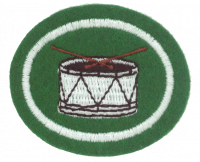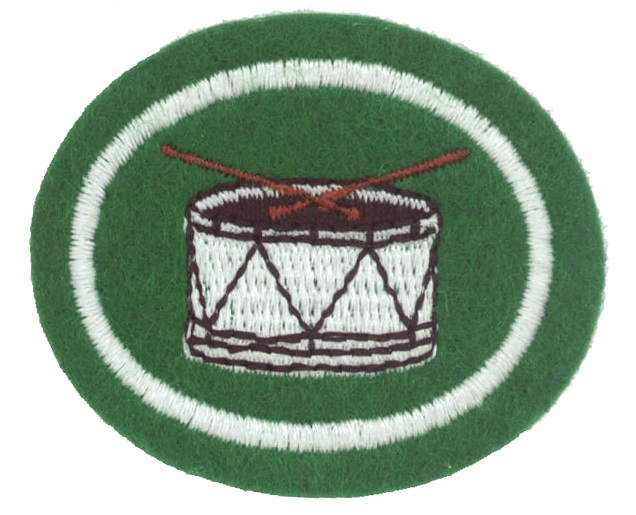Difference between revisions of "AY Honors/Drumming & Percussion/Answer Key/es"
From Pathfinder Wiki
< AY Honors | Drumming & PercussionAY Honors/Drumming & Percussion/Answer Key/es
(Created page with "{{clear}}") |
(Updating to match new version of source page) |
||
| (22 intermediate revisions by 2 users not shown) | |||
| Line 1: | Line 1: | ||
| − | + | {{HonorSubpage}} | |
| − | + | <!--{{Honor Master|honor={{#titleparts:{{PAGENAME}}|1|3}}|master=Recreation}}--> | |
| − | {{ | ||
| − | |||
| − | |||
| − | |||
| − | |||
| − | |||
| − | |||
| − | |||
| − | |||
| − | {{Honor Master | ||
| − | |||
| − | |||
| − | |||
<section begin="Body" /> | <section begin="Body" /> | ||
{{ansreq|page={{#titleparts:{{PAGENAME}}|2|1}}|num=1}} | {{ansreq|page={{#titleparts:{{PAGENAME}}|2|1}}|num=1}} | ||
| Line 33: | Line 20: | ||
{{ansreq|page={{#titleparts:{{PAGENAME}}|2|1}}|num=3}} | {{ansreq|page={{#titleparts:{{PAGENAME}}|2|1}}|num=3}} | ||
<noinclude></noinclude> | <noinclude></noinclude> | ||
| − | <!-- 3. | + | <!-- 3. Ser capaz de nombrar cinco toques elementales de cada una de las cuatro familias de los toques básicos. --> |
| − | |||
| − | |||
| − | |||
{{clear}} | {{clear}} | ||
| Line 60: | Line 44: | ||
{{clear}} | {{clear}} | ||
| − | {{clear}} | + | {{clear}} |
{{clear}} | {{clear}} | ||
| Line 89: | Line 73: | ||
{{ansreq|page={{#titleparts:{{PAGENAME}}|2|1}}|num=7}} | {{ansreq|page={{#titleparts:{{PAGENAME}}|2|1}}|num=7}} | ||
<noinclude></noinclude> | <noinclude></noinclude> | ||
| − | <!-- 7. | + | <!-- 7. ¿Cuál es la diferencia entre tocar abierto y tocar cerrado? --> |
<noinclude></noinclude> | <noinclude></noinclude> | ||
{{CloseReq}} <!-- 7 --> | {{CloseReq}} <!-- 7 --> | ||
{{ansreq|page={{#titleparts:{{PAGENAME}}|2|1}}|num=8}} | {{ansreq|page={{#titleparts:{{PAGENAME}}|2|1}}|num=8}} | ||
<noinclude></noinclude> | <noinclude></noinclude> | ||
| − | <!-- 8. | + | <!-- 8. Usando el método abierto/cerrado, demostrar su conocimiento de los siete toques esenciales. Ejecutar: abierto a cerrado a abierto --> |
{{clear}} | {{clear}} | ||
| − | + | {{clear}} | |
<noinclude></noinclude> | <noinclude></noinclude> | ||
| Line 104: | Line 88: | ||
{{ansreq|page={{#titleparts:{{PAGENAME}}|2|1}}|num=9}} | {{ansreq|page={{#titleparts:{{PAGENAME}}|2|1}}|num=9}} | ||
<noinclude></noinclude> | <noinclude></noinclude> | ||
| − | |||
| − | |||
| − | |||
| − | |||
| − | |||
| − | |||
<noinclude></noinclude> | <noinclude></noinclude> | ||
| Line 115: | Line 93: | ||
{{ansreq|page={{#titleparts:{{PAGENAME}}|2|1}}|num=10}} | {{ansreq|page={{#titleparts:{{PAGENAME}}|2|1}}|num=10}} | ||
<noinclude></noinclude> | <noinclude></noinclude> | ||
| − | <!-- 10. | + | <!-- 10. ¿Cuál es la diferencia entre las baquetas utilizadas para una banda marcial de marcha y las utilizadas para una batería? --> |
| − | |||
| − | |||
| − | |||
| − | |||
<noinclude></noinclude> | <noinclude></noinclude> | ||
| Line 125: | Line 99: | ||
{{ansreq|page={{#titleparts:{{PAGENAME}}|2|1}}|num=11}} | {{ansreq|page={{#titleparts:{{PAGENAME}}|2|1}}|num=11}} | ||
<noinclude></noinclude> | <noinclude></noinclude> | ||
| − | <!-- 11. | + | <!-- 11. ¿Cuáles son las secciones que componen una banda marcial? --> |
| − | + | {{clear}} | |
| − | + | {{clear}} | |
<noinclude></noinclude> | <noinclude></noinclude> | ||
| Line 135: | Line 109: | ||
{{ansreq|page={{#titleparts:{{PAGENAME}}|2|1}}|num=12}} | {{ansreq|page={{#titleparts:{{PAGENAME}}|2|1}}|num=12}} | ||
<noinclude></noinclude> | <noinclude></noinclude> | ||
| − | <!-- 12. | + | <!-- 12. Sobre la base de la pregunta anterior, ¿cuál es el propósito de cada una de las secciones? --> |
| − | |||
| − | |||
| − | + | {{clear}} | |
| − | |||
| − | + | {{clear}} | |
| − | |||
| − | + | {{clear}} | |
| − | |||
| − | + | {{clear}} | |
| − | |||
<noinclude></noinclude> | <noinclude></noinclude> | ||
| Line 155: | Line 123: | ||
{{ansreq|page={{#titleparts:{{PAGENAME}}|2|1}}|num=13}} | {{ansreq|page={{#titleparts:{{PAGENAME}}|2|1}}|num=13}} | ||
<noinclude></noinclude> | <noinclude></noinclude> | ||
| − | <!-- 13. | + | <!-- 13. Mostrar las diferentes clases de dispositivos de protección utilizados para proteger los equipos de la banda marcial. --> |
<noinclude></noinclude> | <noinclude></noinclude> | ||
{{CloseReq}} <!-- 13 --> | {{CloseReq}} <!-- 13 --> | ||
{{ansreq|page={{#titleparts:{{PAGENAME}}|2|1}}|num=14}} | {{ansreq|page={{#titleparts:{{PAGENAME}}|2|1}}|num=14}} | ||
<noinclude></noinclude> | <noinclude></noinclude> | ||
| − | <!-- 14. | + | <!-- 14. ¿Cuáles son las diferentes clases y tamaños de baquetas utilizado para una banda marcial? --> |
| − | |||
<noinclude></noinclude> | <noinclude></noinclude> | ||
{{CloseReq}} <!-- 14 --> | {{CloseReq}} <!-- 14 --> | ||
{{ansreq|page={{#titleparts:{{PAGENAME}}|2|1}}|num=15}} | {{ansreq|page={{#titleparts:{{PAGENAME}}|2|1}}|num=15}} | ||
<noinclude></noinclude> | <noinclude></noinclude> | ||
| − | <!-- 15. | + | <!-- 15. Saber qué herramientas y equipos son utilizados para la sesión de práctica de tambores. --> |
| − | |||
<noinclude></noinclude> | <noinclude></noinclude> | ||
{{CloseReq}} <!-- 15 --> | {{CloseReq}} <!-- 15 --> | ||
<noinclude></noinclude> | <noinclude></noinclude> | ||
| − | |||
| − | |||
| − | |||
| − | + | ==Referencias== | |
| − | |||
| − | |||
| − | |||
| − | |||
| − | |||
| − | = | ||
{{reflist}} | {{reflist}} | ||
<noinclude></noinclude> | <noinclude></noinclude> | ||
| − | + | {{CloseHonorPage}} | |
| − | |||
Latest revision as of 16:30, 14 July 2022
Tamboreo y percusión
Nivel de destreza
2
Año
2006
Version
14.05.2024
Autoridad de aprobación
Asociación General
1
Escribir una página donde demuestre su conocimiento de cómo una banda marcial de marcha puede ser usada para ministrar dentro de:
a. La iglesia local
b. La comunidad
a. La iglesia local
b. La comunidad
2
¿Cuáles son las cuatro familias de toques básicos de tambores de marcha?
3
Ser capaz de nombrar cinco toques elementales de cada una de las cuatro familias de los toques básicos.
4
Demostrar capacidad para mantener el paso con la banda marcial tomando parte en al menos un programa de ministerio (por ejemplo, día del Conquistador, evento patrocinado por la asociación o por la iglesia local).
5
¿Cuál es la diferencia entre cargadores de tambor y correas de tambor? Demostrarlo con un equipo de tambores en formación.
6
¿Cuáles son los siete toques esenciales? ¿Por qué son esenciales?
7
¿Cuál es la diferencia entre tocar abierto y tocar cerrado?
8
Usando el método abierto/cerrado, demostrar su conocimiento de los siete toques esenciales. Ejecutar: abierto a cerrado a abierto
9
¿Cuál es la diferencia entre el estilo tradicional y el estilo combinado con la batuta? Demostrar cada estilo de toque por una secuencia que consta de no menos de tres toques.
10
¿Cuál es la diferencia entre las baquetas utilizadas para una banda marcial de marcha y las utilizadas para una batería?
11
¿Cuáles son las secciones que componen una banda marcial?
12
Sobre la base de la pregunta anterior, ¿cuál es el propósito de cada una de las secciones?
13
Mostrar las diferentes clases de dispositivos de protección utilizados para proteger los equipos de la banda marcial.
14
¿Cuáles son las diferentes clases y tamaños de baquetas utilizado para una banda marcial?
15
Saber qué herramientas y equipos son utilizados para la sesión de práctica de tambores.


